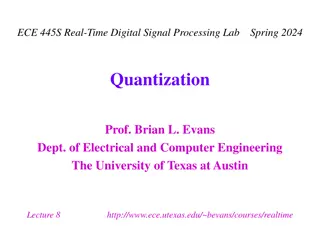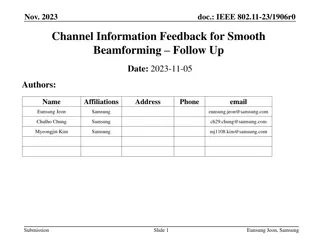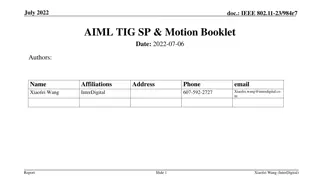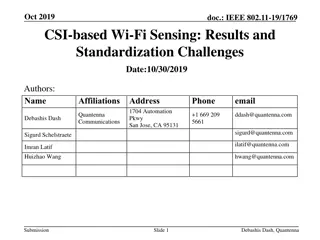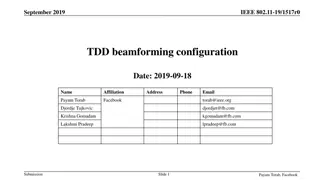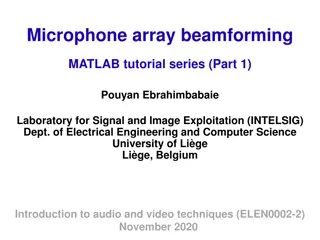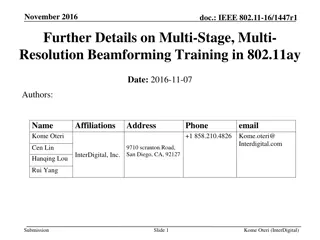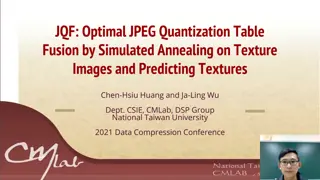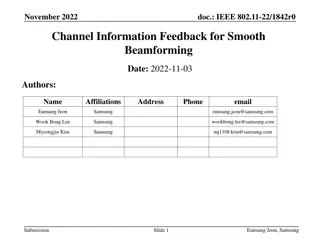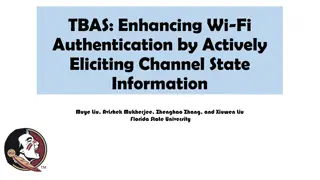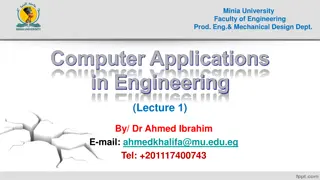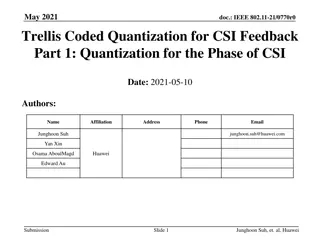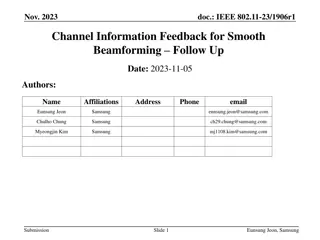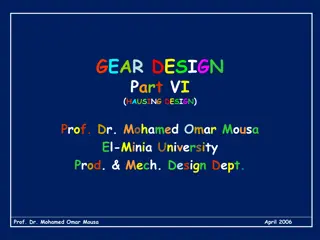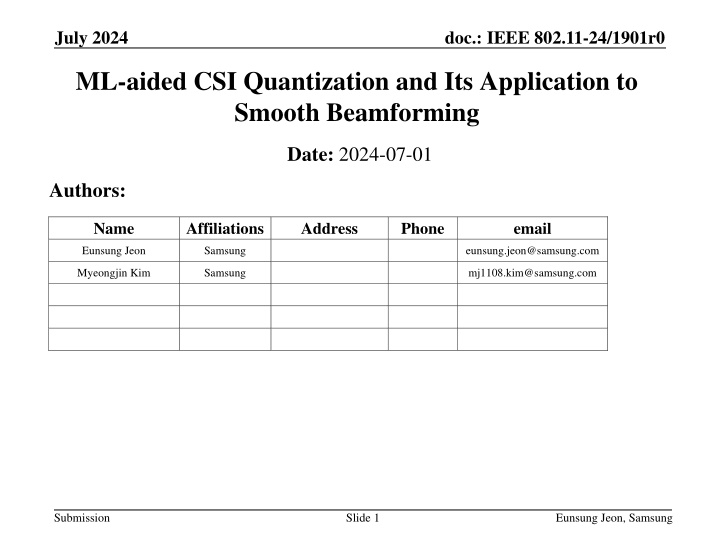
Smooth Beamforming Techniques for Improved Wireless Communication
Explore ML-aided CSI quantization techniques in IEEE 802.11-24/1901r0 standard for smooth beamforming. Learn about feedback schemes enhancing beamforming matrix continuity, leading to throughput gains with minimal CSI overhead. Discover optimal methods and closed-form solutions for maximizing beamforming matrix smoothness and cross-correlation, revolutionizing wireless communication efficiency.
Download Presentation

Please find below an Image/Link to download the presentation.
The content on the website is provided AS IS for your information and personal use only. It may not be sold, licensed, or shared on other websites without obtaining consent from the author. If you encounter any issues during the download, it is possible that the publisher has removed the file from their server.
You are allowed to download the files provided on this website for personal or commercial use, subject to the condition that they are used lawfully. All files are the property of their respective owners.
The content on the website is provided AS IS for your information and personal use only. It may not be sold, licensed, or shared on other websites without obtaining consent from the author.
E N D
Presentation Transcript
July 2024 doc.: IEEE 802.11-24/1901r0 ML-aided CSI Quantization and Its Application to Smooth Beamforming Date: 2024-07-01 Authors: Name Affiliations Address Phone email Eunsung Jeon Samsung eunsung.jeon@samsung.com Myeongjin Kim Samsung mj1108.kim@samsung.com Submission Slide 1 Eunsung Jeon, Samsung
July 2024 doc.: IEEE 802.11-24/1901r0 Introduction During the TGbn session in last May meeting, a new channel state information (CSI) feedback scheme was presented for smooth beamforming [1]. A slight increase in CSI feedback overhead can solve the discontinuity issue in beamforming matrix, leading to significant throughput gain. It is optimal maximizing smoothness of beamforming matrix. Receiver can enjoy more channel smoothing (~2.5dB). Following [1], we first present a sub-optimal method for smooth beamforming, which requires no additional CSI feedback. And then, we incorporate the machine learning (ML) technique to further reduce CSI feedback overhead. Submission Slide 2 Eunsung Jeon, Samsung
January 2023 doc.: IEEE 802.11-24/1901r0 Recap: Beamforming Procedure For transmit beamforming, BFer requires the channel state information (CSI), which is delivered from the BFee. BFer sends an NDP for sounding purpose. BFee feeds back CSI. Estimated channel matrix H is decomposed to U?Vh via SVD and V is chosen as a beamforming feedback matrix (BFM). The BFM is compressed in form of angles (?,?) by using the Givens rotation. The codebook size (i.e., number of bits for quantization to the angles) and subcarrier grouping size are determined by BFee. BFer reconstructs V and applies it for the beam-steering matrix. Submission Slide 3 Eunsung Jeon, Samsung
July 2024 doc.: IEEE 802.11-24/1901r0 Smooth Beamforming Feedback [1] Conventional Proposed (Step 1) SVD(H) = U?Vh H: channel estimates ?12???12 ?22???22, ?: diagonal matrix with singular value. (Step 2) Column-wise phase shift - Multiply a diagonal matrix ? . - The elements in the last row become a complex number. - Optimal in terms of maximizing the smoothness. ?11???11 ?21???21 U, V: unitary matrix, E.g.? = - Multiply a diagonal matrix ?. - The elements in the last row become a real number. - Optimal in terms of minimizing the CSI feedback overhead. ? = ?? ? = ?? ) ) ?11??(?11+?1 ?21??(?21+?1 ?12??(?12+?2 ?22??(?22+?2 ?12??(?12 ?22) ?22 ?11??(?11 ?21) ?21 = = ) ) where ? = ? ??21 where ? = ???1 0 0 ? ??22 0 ???2 0 (Step 3) Compression of Q using Givens rotation Submission Slide 4 Eunsung Jeon, Samsung
July 2024 doc.: IEEE 802.11-24/1901r0 Optimal Method [1] (1/2) ? can be obtained by solving the following optimization problem. This is optimal in terms of maximizing the cross-correlation of two adjacent beamforming matrices. = arg max Xcor ?? 1,??? , where Xcor(A, B) Re{Tr(A ?)} ?? ? The closed-form solution is given as [2], [3], [4]. ,???2 , ,????? = diag ???1 ?? where (??[?]) ?? 1? (??[?]) ?? 1?, ? = 1,2, ,?? ??[?] is the i-th column of V V for the k-th subcarrier. ??[?] is the i-th column of Q Q for the (k-1)-th subcarrier. = ???? Submission Slide 5 Eunsung Jeon, Samsung
July 2024 doc.: IEEE 802.11-24/1901r0 Optimal Method [1] (2/2) Sequential processing The optimization is performed sequentially from the beginning to the end of the subcarriers. Submission Slide 6 Eunsung Jeon, Samsung
July 2024 doc.: IEEE 802.11-24/1901r0 CSI Feedback Overhead The number of angles is increased by the number of columns in the beamforming matrix (??). ??numer of ????, (? = 1,2, ,??) is newly added in the Compressed Beamforming Feedback Matrix subfield. E.g., Red marked angles in the table below. In the next slide, we will show a sub-optimal method that does not require additional CSI feedback overhead. Size of V Number of angles Angles in the Compressed Beamforming Feedback Matrix subfield 11, 21, 31, 41, 51, 61, 71, 81, 21, 31, 41, 51, 61, 71, 81 14 15 8 1 11, 21, 31, 41, 51, 61, 71, 81, 22, 32, 42, 52, 62, 72, 82, 21, 31, 41, 51, 61, 71, 81, 32, 42, 52, 62, 72, 82 26 28 8 2 Submission Slide 7 Eunsung Jeon, Samsung
July 2024 doc.: IEEE 802.11-24/1901r0 Sub-optimal Method (1/2) The sub-optimal method consists of two processes: (i) Discontinuity detection (ii) { , } angular interpolation across subcarriers to resolve the discontinuity The discontinuity detection finds subcarrier indices in which the cross correlation between two adjacent beamforming matrices is less than a predefined threshold (T). ??= arg ????? < ? ??= arg ????? > ? Re (??[?]) ?? 1? (??[?]) ?? 1? where ? ?,? = ????? = min?? ?,? for ? = 1,2, ,?? . Submission Slide 8 Eunsung Jeon, Samsung
July 2024 doc.: IEEE 802.11-24/1901r0 Sub-optimal Method (2/2) The angular interpolation is performed for consecutive subcarriers, starting at ?? and ending at ??. ? ?? ?? ?? ? ?? ?? ?? where mod(,2?) is the modulo operation w.r.t. 2?. ?(?) and ?(?) is the k-th subcarrier for ? and ? angles, respectively. ?(?)= mod ?(??) ?(??)+ ?,2? ? + ?(??) ?(?)= ?(??) ?(??)+ ?(??) Submission Slide 9 Eunsung Jeon, Samsung
July 2024 doc.: IEEE 802.11-24/1901r0 ML-aided CSI Quantization (1/2) Using the channel estimates from the received NDP, receiver (BFee) calculates two types of channel characteristics in the time domain and the frequency domain, respectively. The variance of the channel frequency response (CFR) 2 2 1 ?? 1 1 1 ? ?=0 ?? 1 ?=0 ? 1 ??(?,?) ? 1 ??(?,?) 2= ???? ?=0 ? ?=0 ?? ??(?,?) is the estimated channel for the k-th subcarrier for the ij-th element The mean channel delay spread of the channel impulse response (CIR) 1 ?? 1???? ? ?,? ?? 1 ?=0 ???? ?=0 ?????= where ? ?,? = ? ?? (?,?) ??+ (?,?) , IDFT( ) is the inverse DFT function Submission Slide 10 Eunsung Jeon, Samsung
July 2024 doc.: IEEE 802.11-24/1901r0 ML-aided CSI Quantization (2/2) ML classifies the channel selectivity by using an unsupervised learning-based K-means algorithm. It finds the two centroids of ?? The classification is determined base on the minimum Euclidean distance between ?? The CSI quantization level is adaptively determined based on channel-type classification result. 2,????? in an iterative manner. 2,????? and its two centroids. Submission Slide 11 Eunsung Jeon, Samsung
July 2024 doc.: IEEE 802.11-24/1901r0 Simulation Parameters Link level simulator parameters In order to consider the CSI feedback overhead, throughput performance is evaluated by ?????1 PER /?? ?????+????+????+?????+3????? Throughput (Mbps/Hz) = Submission Slide 12 Eunsung Jeon, Samsung
July 2024 doc.: IEEE 802.11-24/1901r0 Cross-correlation Comparison We can see that the cross-correlation of the proposed smooth beamforming method mostly fall in the range of [0, 1] while the conventional method goes over in the range [-1, 0] with non- negligible percentage. This verifies the significant smoothness improvement of the proposed two methods. [Snap-shot] [Histogram] Submission Slide 13 Eunsung Jeon, Samsung
July 2024 doc.: IEEE 802.11-24/1901r0 Performance Evaluation (1/3) We can see that conventional CSI feedback method suffers from severe performance degradation showing error-floor due to the discontinuity of the beamforming matrix. The sub-optimal method shows a gain of about 2dB at PER=0.1 compared to the conventional one. In case of the optimal method, a gain of about 4dB is obtained at PER = 0.1 compared to conventional one. Additional 1dB gain can be obtained by combining the smooth BFer algorithm. Submission Slide 14 Eunsung Jeon, Samsung
July 2024 doc.: IEEE 802.11-24/1901r0 Performance Evaluation (2/3) When integrating ML-aided CSI quantization, both conventional and proposed methods can reduce the amount of CSI feedback overhead about 27%. With the conventional CSI method as the baseline, The optimal method has only 88% (i.e., 2879/3256) of the baseline. It is further reduced to 73% (i.e., 2408/3256) when the sub-optimal method is used. Submission Slide 15 Eunsung Jeon, Samsung
July 2024 doc.: IEEE 802.11-24/1901r0 Performance Evaluation (3/3) Effect of the ML-aided CSI quantization to the performance For the sub-optimal method, performance loss is negligible, when applying the ML-aided adaptive quantization scheme. For the optimal method, the loss of PER is negligible for MCS 9, while it shows a loss of about 1dB for MCS 11. Since the optimal method requires additional CSI (i.e., ? angles), and thus it is more sensitive to the CSI quantization effect, especially for high QAM. Submission Slide 16 Eunsung Jeon, Samsung
July 2024 doc.: IEEE 802.11-24/1901r0 Summary In this contribution, we presented CSI feedback method for smooth beamforming in both optimal and sub-optimal ways. Optimal method Additional channel information is feedback to maximize the cross-correlation between adjacent beamforming matrices. Sub-optimal method A threshold-based adaptive angular interpolation is used to improve smoothness without increasing the CSI feedback overhead. In order to reduce CSI feedback overhead, the proposed two methods are integrated with the ML-aided CSI quantization. The CSI quantization level is dynamically determined by using the K- means based channel type classification results. The simulation results showed that the proposed optimal / sub- optimal CSI feedback methods for smooth beamforming combined with ML-aided CSI quantization can significantly improve throughput with reduced CSI feedback overhead. Submission Slide 17 Eunsung Jeon, Samsung
July 2024 doc.: IEEE 802.11-24/1901r0 Reference [1] 802.11-23/1906r1, Channel Information Feedback for Smooth Beamforming Follow-up, Samsung. [2] E. Sengul, H. J. Park and E. Ayanoglu, Bit-Interleaved Coded Multiple Beamforming with Imperfect CSIT, IEEE Trans. Commun, vol. 57, no. 5, May 2009. [3] E. Jeon, M. Ahn, S. Kim, W. B. Lee and J. Kim, "Joint Beamformer and Beamformee Design for Channel Smoothing in WLAN Systems," in Proc. IEEE 92nd Veh. Technol. Conf. (VTC2020-Fall), Nov. 2020. [4] Y. Qui, D. Qu, Da Chen and T. Jiang, Smoothed SVD-based Beamforming for FBMC/OQAM Systems Based on Frequency Spreading, in Proc. IEEE Global Communications Conference (GLOBECOM), Dec. 2016. [5] E. Jeon, M. Kim, M. Ahn, J. Lee, S. Kim, I. Kim and J. Kim, Machine Learning Aided CSI Feedback for Smooth Beamforming in Next Generation WLANs, submitted to IEEE Global Communications Conference (GLOBECOM), Dec. 2024. . Submission Slide 18 Eunsung Jeon, Samsung


